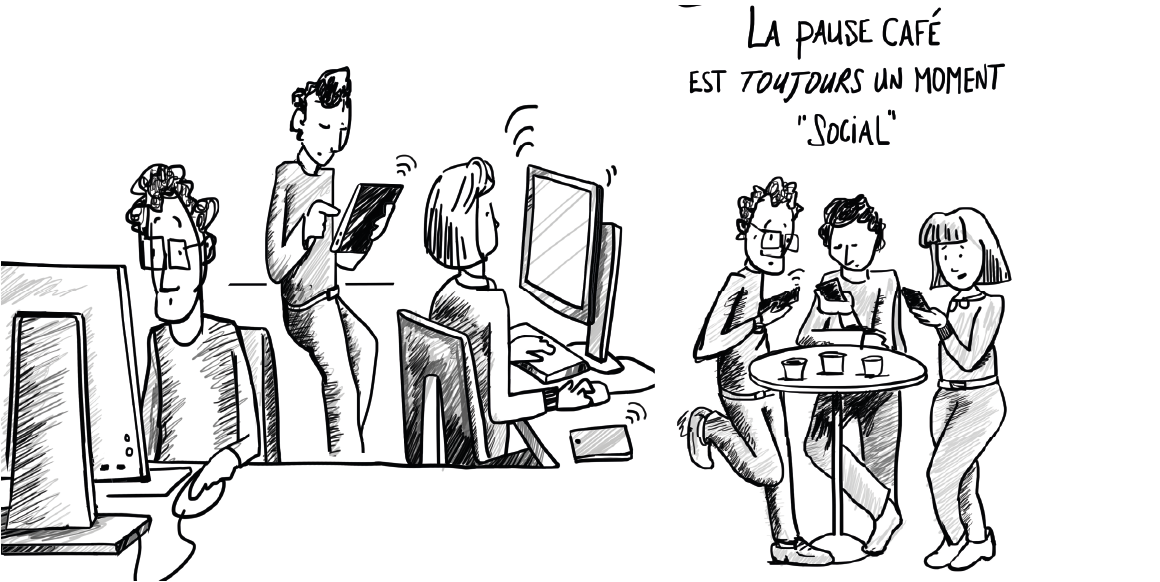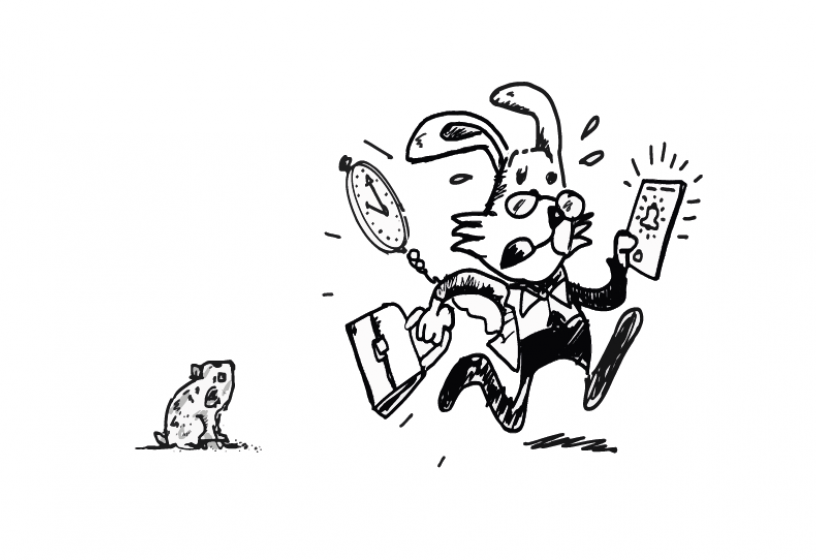Quick and Dirty! Facing the Diktat of Urgency at Work

Exponentially digital professional practices increase evermore the speed of information exchanges. Besides, they amplify answers to be expected faster and faster until being almost instantaneous. They also reinforce the matrix evolution of management systems. Pieces of information arrive anytime from anywhere. They set the rhythm of work organisations and professional relationships. The information stake then takes a temporal form. Time dedication for information processing is taking over productive times, recovery breaks or reflections. What are the impacts on well-being and performance within the professional scope?
Obviously, time in itself has not been modified. It is, indeed, our perception of it that got influenced by an atmosphere of the constant need for adaptability and emergencies. At the heart of the phenomenon: multiple, multiform and multi-channel information arising without being planned, desired, researched or useful. Emails, calls, messages, notifications… These digitised accentuated cognitive solicitations usually generate the interruption of a task in aid of a “new urgency” to be dealt with ASAP.
The reactivity diktat becomes increasingly pressing. When a several days response was formerly satisfactory, a nearly immediate reaction to all digital requests is now expected. Françis Jauréguiberry, a sociologist specialised in information and communication technology uses, highlights this situation by explaining that, nowadays, not providing a prompt reply implies the need for justification or even apology. This daily professional life sequenced by an ever-increasing number of notifications affects jobs with required periods of intense concentration and continuity of execution.

Reacting on the spot: a threat to the quality of work
A result of this ever more fragmented time and these injunctions to react in real-time is infobesity. It refers to a triple overload: of information, communications and cognitive solicitations. Infobesity is the imbalance between received information and one’s ability to process them without harming either the activity or the person. Its specificity lies in existing under both an individual and a collective form. For individuals, it is recognised amongst psychosocial risks. Being overexposed to information and professional communications in general, leads to significant consequences: chronic stress, attention deficit, quality of decisions decrease, behavioural addiction development, fear of error, limited creativity and disengagement of employees. In terms of physical health, appearance of psychosomatic, cardiovascular and muscular disorders may be noticed.
For organisations, this represents the risk of increased sick leaves, accelerated employee turnover, reduced quality of information, but above all, a risk of lowered agility, productivity and innovation potential. Here are some tips that may help to maintain qualitative work, performance and well-being in this global race against emergency and immediacy.
Master your mailbox
Digital devices in themselves do not have negative or positive impacts: if anything, ways of using them may be problematic. Therefore, learning how to choose the suitable tool for each situation is an undeniable collective need. Let’s take a closer look at the email. Since the end of the ninetie, thanks to its low direct financial costs and its capacity to remove temporal and geographical boundaries, it has become the universal tool for professional communications. In 2018, 293 billion emails (excluding spams) were sent every day in the world, being 325,231 emails every second. Are all these exchanges useful and essential? It seems unlikely as 80 % of sent emails are never opened by their addressee. This non-optimised, sometimes excessive, use of emails represents, on the one hand, a significant contribution to the phenomenon of communicational and informational overload and on the other hand a substantial ecological cost for the Earth. Let’s remember that a 100 of sent emails equals, on average, to one kilogram of CO2, which is the equivalent of 4.5 kilometres of a car ride.
Moreover, in professional communications, it is essential to distinguish synchronous and asynchronous reach outs. First ones are intrusive and actively engage the recipient as the telephone does, for example. Quite the opposite, asynchronous media are far less constraining when properly used. The primary interest of emailing is precisely its asynchronous nature. Emails are supposed to let each user organise its received information according to its schedule without being subjected to others’ simultaneous availability. By no means, emails are relevant to alert about an emergency. Nevertheless, the widespread habit of leaving the mailbox opened as desktop background leads to being interrupted equally by a significant request, a newsletter or an internal communication cced “for information” to everyone.
Differentiate urgent and important
Work organisation now implies almost systematic emergency management. By withdrawing into short term stakes, an organisation only reacts on the spot. This operation is carried out at the expense of a vision, global goals serving as development policies that would be resilient in the long run. Too often, the idea of emergency prevails over the concept of importance. This paradigm influences work rhythms, and the commitment level allocated to a task. In other words, in the daily professional life, the hallmark of importance is left aside in aid of responding as fast as possible to each random urgency. It is then the unpredictable amount of time left “free” between the announcement of an emergency and the notification of the next one that defines the depth, the quality and the accuracy of the work. This situation holds many risks. It is therefore primordial to stimulate the capacity to cut loose from the rhythm of notifications and to adapt work organisation which comply by the necessary distinction between important activities and urgent activities.
The former Vice-President of the United-States Dwight D. Eisenhower said: “what is important is rarely urgent. And what is urgent is hardly ever important”. His most known legacy is a matrix used to organise task realisation in everyday life.
Stepping back from the low-gazed society
When virtuality takes over reality
All eyes staring at screens show how substantially the digital age influences our life. Cyber dependency and communicational addictions -characterised by a fear of missing something out or by an intense desire to receive emails or other notifications- share similar symptoms with a psychosocial addiction. These obsessional behaviours are usually observed by loved ones but kept (even denied) by the subject.
They are time-consuming and happen at the cost of other activities and human interactions. From now on, these addictions exist continuously and without separation between professional and personal spheres. Moreover, we dive into a paradoxical situation where communications between people are creating isolation and social relationships disembodiment. Technologies of information and communication development may foster work relations deterioration and boost virtual management systems which are intrusive, even invasive, and based on control or traceability.
Being agile to be happy?
If time is the sesame, then the key is agility! Combine permanent availability, constant interactivity and instantaneous reactions, and you will get... a false definition of agility. This trendy notion’s meaning has been adapted in every conceivable way to fit to recent work mode upheavals miraculously. The shortcut was tempting: brandish the word “agility”, and there you are, with the genuine authority to demand full connection splits and triple time-axels from employees. Result: collective hyper connection and appearance of digital phobias.
Yet, agile business is indeed the key! Picture your team as a self-adaptive living organism, aware that it will change but with unpredictable-ended cycles. You will then develop adaptation and dynamic steering within a framework which integrates freedom of work and improvement will for and by everyone. Let’s keep in mind that agility comes from the digital and start-up world. It is originally a work method allowing to increase customers’ satisfaction (by removing the realisation tunnel) but also development teams’ one. In this case, reactivity is built collectively thanks to a suited collaboration that does not decree the unreasonable instantaneity diktat as a principle.

What if being agile meant taking the time?
A part of individuals’ nature loves speed, acceleration and thrills that result from it. There is something useful and liberating about speed. The sociologist Hartmut Rosa’s works in recent decades show that time structures can be described as a triple acceleration. The technological one refers to the increasing pace of innovation in transports, communications and production. The social one relates to changes in social institutions, including interactions between private and professional spheres. And last, the life one refers to the existential experience of contemporary people who now go speed dating and eat in restaurants.
In the opposite direction, there is an expansion of “slow” trends such as slow digital, slow tech, slow food. Philosopher Alain Badiou speaks of "the need for each person to construct its actions in a time frame that is distinct from the dominant temporality of capital, circulation, productivity and rapidity. It is a matter of taking shelter from rapid result obsession, building places, relationships, and projects to be protected of it. In his opinion, when facing a hectic, sometimes even hysterical temporality, nothing is sustainable without conquering our own slowness. And all values that are not based on short-term efficiency presuppose a certain slowness, meditation, reflection, and dream. To sum up, thinking takes time. And to have time, you have to take it.
Nowadays, this ever-accelerating society arises the question: when is it ok to stop, to take a break? Because, our humanity also depends on the creativity emerging from boredom, contemplation, reflection and meaningful and emotional moments. More fundamentally, it is about learning to take enough time to live with time. At its own intensity, as there is not any way to change it. Retrieve our attention and some cohesion within the metronome of our lives, to finally find, as Hartmut states, moments of resonance.
Also to be read in the dossier "Fast Mode":


